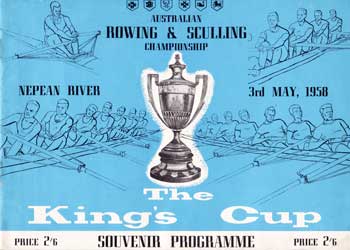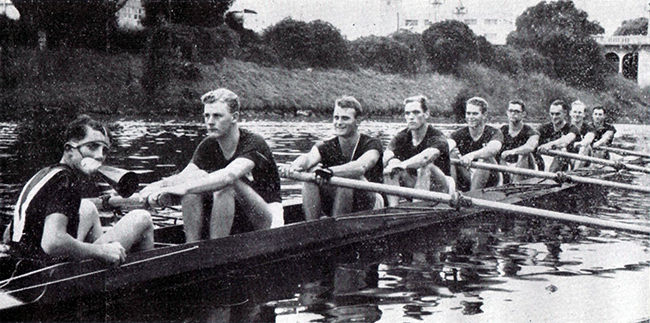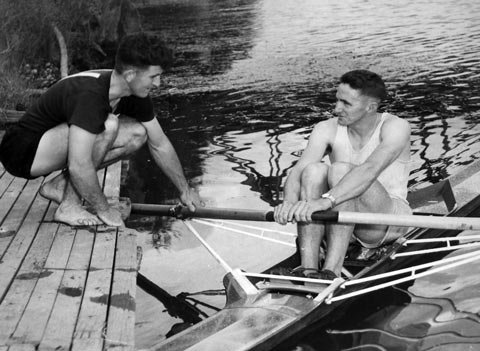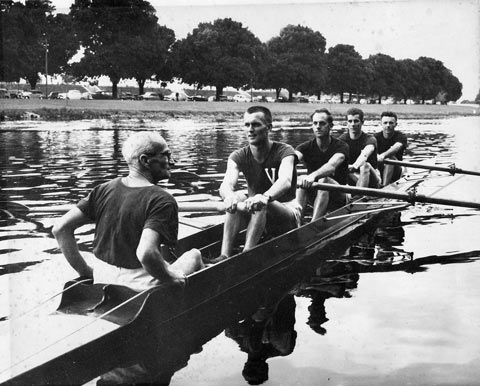1958 Interstate Championships
Women's: 12 Apr 1958, Yarra River VIC
Men's: 3 May 1958, Nepean River NSW

1958 Programme Cover for the Men's Interstate Championships
The men's championships introduced a new event with the lightweight four.Index to Results
- Men's Eight–King's Cup
- Men's Sculling–President's Cup
- Men's Lightweight Four–Penrith Cup
- Women's Four–ULVA Trophy
Full definition images for these championships can be found on the Australian Rowing Images website.
Organising Committee & Officials
Organising Committee Chairman: George Bawtree
Starters: Ossie N Rosevear & John R Wilton
Umpires: Tom C Nickson & Victor A Mossong
Judges: William F Bradley & George F Ashley
Timekeepers: Noel Parsons & Laurie E Stepto
Clerk of Scales: Malcolm (Mac) Ruffels
Despatch Steward and course manager: Maurie (Mo) T Reddan
70th Men's Interstate Eight-Oared Championship–The King's Cup
Time: 15.50
Margin: 1 1/2 lengths
1st VIC - Bow: Hubert R Frederico, 2: David H Boykett, 3: Jack Morganti, 4: Terry R Davies, 5: J Kim M Jelbart, 6: Robert L Simpson, 7: Ian E Douglas, Str: Geoff M Taylor, Cox: Rod C Davies, Coach:Robert R Aitken, Emerg: William S Arnold & Kevin McMahon, Selectors, Harry R Duncan, Ron J March & coach, Mgr Ron J March
2nd WA - Bow: Richard A Child, 2: Frank J Lowry, 3: Milton A Francis, 4: A Max Cunningham, 5: Brian B Coughlan, 6: Peter H Hall, 7: Ken H Butt, Str: Ivan R J Hodgkinson, Cox: Terry J Scook, Emerg: Geoff A Hale, Cch: Eddy K Edwards, Mgr: Robert C Hemery
3rd NSW - Bow: Thomas E Monaghan, 2: Robert Ritchie, 3: John L Burton, 4: H Maxwell Annett, 5: E Chris Spark, 6: Maurice C Grace, 7: Edward R Curtain, Str: Robert T Clark, Cox: Peter McH Tutin, Emergs: Paul Cox & Patrick Burke, Cch: Phillip A Cayzer, Mgr: Milton Kent
4th QLD - Bow: M Leffers, 2: B Wilson, 3: Kenneth Turton, 4: Fred Jaques, 5: R Barnett, 6:Ray Green, 7:J Boyd, Str: B Colquhoun, Cox: W Barnett, Emerg: Ken Goswell, Cch: J Bosler, Mgr: Gus Green
5th TAS - Bow: N P Roberts, 2: D J Bourke, 3: G F Burgess, 4: P H Burgess, 5: Donald F Flakemore, 6: K Brennan, 7: M F Read, Str: R McMullen, Cox: E Holloway, Emergs: R A Holloway & S A Wilson, Cch: Doug F Clark, Mgr: Ivan Short
6th SA - Bow: D Sam Humble, 2; David Glanville, 3: Ian Jamieson, 4: Adrian Jones, 5: Cliff Graetz, 6: Bryan Draper, 7: B Juers, Str: B Walsh, Cox: William Hardy, Emergs; Roger J Luke & Doug Wiles, Cch & Mgr: Harold G (Brick) Pennington
The eights race was a tight race for the first half across across Victoria, WA, NSW and Queensland. However Victoria and WA broke away in the second half in fine style with Victoria leading narrowly. However in the last part of the race, the WA four man collapsed and was supported by the three man. This created the margin of 1 1/2 lengths at the finish. NSW was a further length behind. It was a great performance by the West Australians. The NSW crew was depleted with it's strong representation in the 1958 Empire Games team which was selected in January 1958.

The Victorian crew during training on the Yarra
Bow: Hubert R Frederico, 2: David H Boykett, 3: Jack Morganti, 4: Terry R Davies, 5: J Kim M Jelbart, 6: Robert L Simpson, 7: Ian E Douglas, Str: Geoff M Taylor, Cox: Rod C Davies
Men's Interstate Sculling Championship–The President's Cup
Time: 15.56.0
Margin: 5 lengths
1st NSW - Steve Roll
2nd TAS - Graham Squires
3rd WA - Gerry Hubbard
4th VIC - Don Dudgeon
5th QLD - Ken Goswell
The sculling race saw a fine win to Steve Roll of NSW from Squires of TAS. Roll took the lead half way through the race and led thereafter. Ken Goswell of Queensland dropped out with only a few hundred yards to go.
Steve Roll recalls that he used a boat purchased by his father which was in turn financed mainly by his father's wholesalers of their corner store in Ashfield NSW. Gus Green who managed the Queensland team noticed that Steve was being cut to pieces by the seat in his boat. Gus arranged for a customised cedar seat to be made to suit Steve. Steve commented that it "was the most comfortable sculling seat I had ever sat on and I used it from that day onwards. I asked him how much it would cost. "Win the race and that will do." I obliged."

Don Dudgeon (Vic) speaks with Steve Roll (NSW), 1958 Champion
Men's Interstate Lightweight Four Championship–The Penrith Cup
Distance: 2000m
Margin: 3 feet & 5 lengths
1st VIC - Bow: Robert Tanner, 2: Harry Stevens, 3: George Taylor, Str: Lance Gallagher, Cox: Eddie Jones, Cchs: Wally Graham & Jack Webster, Emerg: S Bulmer, Mgr: Ron J March
2nd NSW - Bow: Ray Bushell, 2: Derrick Docherty, 3: Donald Paterson, Str: John Henderson, Cox: Leonard MacPherson, Emerg: Ian Tutty, Cch: Bert Harding, Mgr: Milton Kent
3rd QLD - Bow: Peter Walsh, 2: A Vidler, 3: R Smith, Str: F Walsh, Cox: L Barnett, Cch: Joe Smithers, Mgr: Angus Green
4th SA - Bow: Gerald Chadwick, 2: Neil Bormann, 3: William (Bill) Banks, Str: John Banks, Cox: Gordon Brock, Emerg: Bruce Bock, Cch: Graham D Coldwell, Mgr: Harold G Pennington
The inaugural lightweight fours Championship was raced over 2000 metres. Queensland led early but by the half way mark the race was between Victoria and NSW. These crews raced furiously over the second half of the race with Victoria winning by only 3 feet.

The Victorian Lightweight Four on the Yarra River
Bow: Robert Tanner, 2: Harry Stevens, 3: George Taylor, Str: Lance Gallagher, Cox: Eddie Jones
The following short history on lightweight rowing appeared in the program for this regatta.
To Canadian Joseph Wright, champion sculler and former coach of the American University of Pennsylvania, must go the credit of the introduction of the Lightweight class of rowing. When Wright took up the position of crew coach at Pennsylvania in 1916 he discovered that he had a number of light but excellent oarsmen not big enough to make the varsity Eight. He evolved the idea of having a crew composed entirely of these lightweight men. The idea quickly spread to other institutions and in 1919 the American Rowing Association officially recognized the 150 lb. class.
The Canadian Association followed the example of the Americans, and and introduced Lightweight rowing to their Canadian Henley Regatta. In 1924 at the U.S.A. Championship Regatta, the first Lightweight National Championships were held in Double Sculls and Fours with cox. The Lightweight Single Sculls Championship followed in 1925, and Eights the following year, 1926.
Apart from the Americans and Canadians, a move was made in the N.S.W. Rowing Association to introduce Lightweight Championships soon after World War I finished. To this Association goes the credit of the first official Championship in this class of rowing. In the 1922-23 season two Championships were held: the Lightweight. Champion Eights of N.S.W., won by the Leichhardt Club, coached by the late Chris Kayser, and the Lightweight Champion Fours, won by Balmain. Other States followed, including Victoria, which first recognized Lightweight oarsmen with an Open Championship of Victoria held during the 1931-32 season, and won by the Richmond Rowing Club.
From time to time in Australia various unofficial races have taken place in different States between Lightweight crews. Nearly twenty-five years ago a Lightweight Eight from the Bendigo Rowing Club came to Sydney on bikes to race at the Balmain Regatta. In more recent times Haberfield have won the Lightweight Challenge Eights at the Australian Henley Regatta in Melbourne, and Leichhardt Club in turn defeated the Queensland champions, Tweed Heads, in a special challenge race arranged at the Grafton "Head of the River" Regatta and went to Victoria to win that State's Lightweight Champion Eight.
As a result of a letter written by the N.S.W.R.A. to the Victorian Association in 1947, a special challenge race was held between the two States at the Olympic Test Regatta on Lake Wendouree, Ballarat, on 3rd January, 1948. The N.S.W. crew, which was boated B. Harding (bow), D. McCray (2), P. McCray (3), K. Bond (stroke), W. Kerr (cox) and Mr. K. Manttan (coach) won a good race from Victoria. It is of interest to note that Bert Harding, bow in this winning crew, has since that date, as a coach, scored more wins with his crews in Lightweight.Championships than any other coach in the history of this class. The cox of this crew, Bill Kerr, had, ten years earlier, steered the Australian crew to victory over New Zealand and Canada at the 1938 Empire Games.
European oarsmen first became aware of the Lightweight class when in the late 1920's several American University 150 lb. crews visited the English Henley Regatta to race in the Thames Cup for Eights. As a result of these visits, which have continued up to the present day, the Lightweight class spread all over Europe, and most of the European countries now have their own Championship in this class.
Just forty years after the first Lightweight race was held in the U.S.A members of F.I.S.A. (the World Rowing Association) met in Belgium and gave official blessing to Lightweight oarsmen. All countries at the meeting saw the need for a Lightweight class of rowing, but there was a good deal of argument as to what the weight should be. The American delegate showed to the members present the U.S. Army report on World War II, which stated that the average weight of over nin
million men, weighed on being drafted into the services, was 150 lbs.
It was then moved and passed by F.I.S.A. that the Lightweight limit for all International races in this class would be 10 St. 10 lbs.; that all such International races would be rowed over 2000 metres, and that oarsmen taking part in such races would have to make the weight on the day of the actual race.
Thus, on the Nepean River at Penrith on Saturday, 3rd May, the first official Lightweight Championship of Australia will be held with crews from most of the Australian States taking part. There is a move from Europe to have this class of event included at future Olympic Games. This year Lightweights have been able to win State blazers. Who knows, but that in the years to come they may be able to represent Australia at the Olympic Games.
Women's Interstate Four-Oared Championship–The ULVA Trophy
Time: 4.52.5
1st NSW - Bow: Jennifer Stillman, 2nd Hazel Horth, 3rd Doreen Addison, Str: Isa Schroeder, Cox: James Cook, Cch: Robert (Bob) F Saville
2nd QLD - Bow: P Radcliffe, 2: Gwen O'Keefe, 3: P Vollmerhausen, Str: M Tierney, Cox: J Moffatt, Cch: Mr J Smithers
3rd VIC
The NSW crew led from start to finish. The Queenslander's race was described as "plucky" despite being outclassed by NSW and finishing 2 lengths in front of Victoria.

NSW Crew in Melbourne
Sources
- Regatta program
- Victorian Rowing Association annual report
- Author's records

